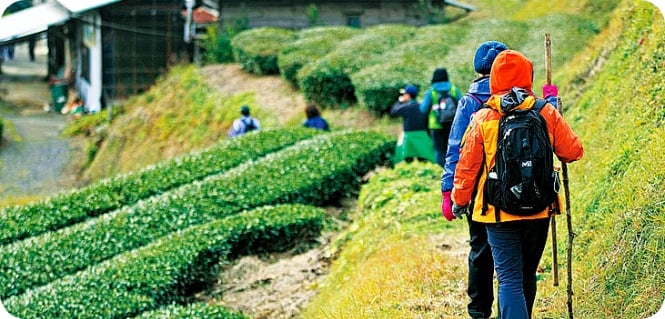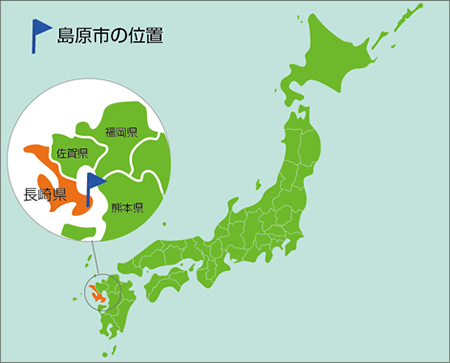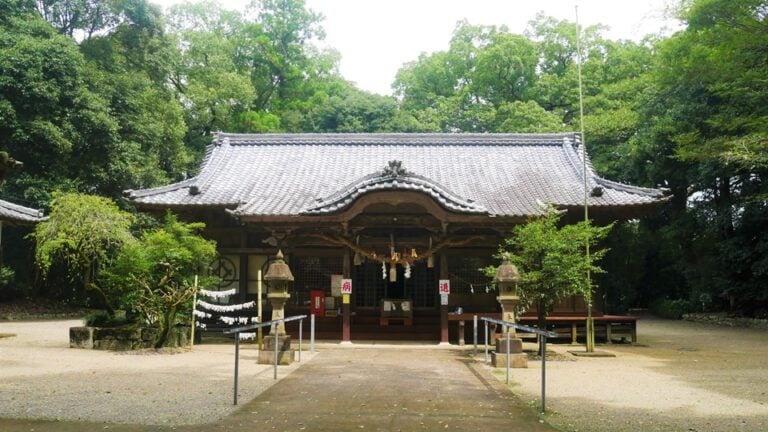
My first visit to Japan was on a 6-month study abroad stint in Kumamoto. Almost 10 years later, I was placed in Nagasaki City as an ALT. Having only ever lived on the island of Kyūshū, I am a proudly self-proclaimed Kyūshū Girl. While I have loved visiting other parts of the country, each time I come back to this island, I am reminded of why I love it so much. The food is delicious, the people are warm and friendly, and the nature is both easily accessible and breathtaking. If I were to ever apply for a new job, I would do my very best to stay on the island.
One of the coolest parts of Kyūshū lies in its geography. It sits just 462 km (287 miles) away from South Korea, so flights are relatively inexpensive, quick, and there’s even a ferry option that takes you from Fukuoka to Busan. As such, it’s interesting to see how the lines between Korea and Japan blur in these port cities. Food and language are just some of the cultural aspects that have made it across the pond.
One of my favorite activities that Kyūshū has embraced, however, is called オルレ (Olle). Originally a word from the Jeju dialect meaning “the small alley leading to a house from the street”, it has evolved to refer to a trek that stimulates the senses by winding through areas rich in nature that often feature coasts and views of the mountains. If you have never been the happiest of hikers, never fear! Olle, unlike a traditional hike, are akin to a long walk. There is usually one route to follow (between 10 and 12 km), and it doesn’t incorporate the levels of elevation that a hike would. Oftentimes, the path will wind its way through quaint countryside towns nestled among nature. The most strenuous part is that some parts of it follow unpaved, although often-traveled and very safe roads or walking paths. All of this makes for a much more relaxing and accessible experience that anyone who can walk will enjoy!
You can read about all the courses located in Kyūshū on the official Olle Japan website. You’ll find descriptions of landmarks you can see on each trail, as well as distance, time required to complete, and a difficulty level. With 18 different trails in all six prefectures on the island, there’s no shortage of opportunities to explore. Let’s take a look at a few examples.
Minami-Shimabara

The Shimabara peninsula (島原半島) is located in Nagasaki prefecture, and was the site of many historically important events. As the only port open to foreign trade for centuries, Nagasaki city and the surrounding area was once a hub of cultural exchange. Food and festivals were the main goods to be imported, however one of the more controversial facets of foreign culture that made its way into the empire was religion. Christian missionaries established a following in the region that eventually spread as far north as Hokkaidō. However, Christians across the country began to be persecuted by the late 1500s. Minami-Shimabara, therefore, holds much historical weight in the eyes of locals. In fact, one of the ports built 450 years ago to welcome these Christian missionaries is actually where this Olle trail begins: Kuchinotsu Port (口之津港).
Read up on the history of the area, then follow the Olle across fields of vegetables, quaint Japanese homes, and breathe in the salty sea air. Keep an eye out for the Heart Ring and Banyan Tree along the trail as well! Personally, I found walking through an area with such rich history to feel very profound.
To get there from Nagasaki Airport, take the shuttle bus to Isahaya Station (諫早駅), then take the Shimatetsu Bus to Kuchinotsu Port. Look out for the quintessential blue horse and blue/red arrows placed throughout the course to guide you!
Munakata Ōshima
After you’ve had your fill of the bright lights and fast pace in Kyūshū’s largest city, Fukuoka, plan a day trip to a small island (contrary to its name) just off the coast called 大島 (Ōshima). Here, you’ll find an 11.4km-long Olle that is suitable for anyone capable of going for a brisk walk. The course itself takes you across the island, with the final stretch taking you along the coast of this beautiful island. Remember to visit the Munakata-Taisha Nakasu-Miya Shrine (宗像大社中津宮)along the way! It’s said that the daughter of Amaterasu, the sun goddess, is enshrined here.
If you plan your Olle for the warmer months, consider bringing a bathing suit! Towards the end of the trail, you will pass Kansu Beach (かんす海水浴場). After a few hours of walking around the island, you’ll be so grateful to past you for bringing it!
To get to Ōshima Port from Fukuoka, you’ll first need to get to Kōnominato Port (神湊). From Hakata Station, it’s a straightforward journey, although it will take you about an hour and twenty minutes. Take the Kagoshima main line to Tōgō Station (東郷駅), then switch to the Nishitetsu Kōnominato bus bound for Hatoba (波止場). Get off at the Kōnominato terminal, and buy tickets to Ōshima island for about ¥560.
Miyazaki Omarugawa

This last course is located in the countryside of Miyazaki. While many Olle are structured in such a way that you end the journey where you began, some take you entirely in one direction only. The Miyazaki Omarugawa course is one of these. You will start your walk inland at Hiki Shrine (比木神社) and finish up at Shigino-no-Hama (鴫野浜), where you can relax by the sea after your journey. This course is said to follow the history of the Baekje royal family, who came to this area from Korea in the 8th century. The prince of the family is said to be enshrined at Hiki Shrine, while the queen at Ōtoshi Shrine (大歳神社), both of which are located along the trail. Make sure to stop at Kijō Onsen (木城温泉), located a little over 4 km into the course.
Given that this trail starts and ends at completely different locations, it’s not as accessible as others. The easiest way to reach the starting point is by car, however you could also take the 花ヶ島・高鍋 (Hanagashima Takanabe) bus from 南宮崎駅前通り (South Miyazaki Station Entrance). Once finished, however, you’ll be quite a ways from where you began. You can always call a taxi to take you back, or do it the old fashioned way and walk back the way you came. If you didn’t drive, it’s about an hour walk to Takanabe Station (高鍋駅) in town because you have to cross the river first. However, once there, you can get to Miyazaki Station directly from Takanabe Station.
What to Wear
Luckily, since Olle’s are not especially strenuous compared to a traditional hike, you won’t need extensive gear. In fact, a small bag in which to carry your phone, sunscreen, and maybe a small snack is likely enough for most. As for clothing, given their laidback nature, Olle’s can be completed wearing whatever you like to wear on any walk around town: leggings or activewear shorts, a breathable shirt, and possibly a hat. Of course, depending on the season you choose to do an Olle, you might want to add one more light extra layer, like a sweater or a windbreaker. However, given its geographic location, the weather very rarely dips below 5° Celsius (41° F). Since you’ll be doing some light exercise as well, it’s unlikely that you’ll need anything too bulky.
Given the nature of an Olle, no matter which trail you choose, you will inevitably pass through small towns and sometimes even very residential neighborhoods that you might otherwise have never seen. This is permitted and, for many locals, a welcomed feature of living on an Olle path. Towards the beginning of my journey with a group of friends, we were even given some local soba by a very kind local woman.
However, given the intimate settings the trails can guide you through, here are some things the official Kyushu Olle website asks of its adventurers:
- Do not enter private property without permission.
- Ask permission before taking photos of people or personal things.
- Please clean up and take your rubbish with you.
- Do not gather any crops on the street without permission.
- Do not pick flowers or twigs on the street.
- Be quiet around private houses.
- As a courtesy to the next visitors, do not untie or remove the blue or red ribbons placed along the trails, as they serve as guides.
- Do not touch guideboards.
- Follow the designated path on unpaved sections of the trail.
- Enjoy the landscape while walking.
- Be mindful of cars when walking along roads.
- Refrain from risky behavior near steep areas and other off-course terrain.
- Smile or greet other visitors/residents you meet while on your trek!
Japanese Olle’s offer a unique way to experience a lesser-known side of Japan. These trails are a fantastic way to see the rich nature, friendly locals, and small towns that are so abundant throughout the country. Given their short distances and accessible design, this is an activity that you can partake in with almost anyone, no matter their level of physical fitness. Olle are perfect for anyone looking to experience Kyūshū in a slow, meaningful way.
Given the nature of an Olle, no matter which trail you choose, you will inevitably pass through small towns and sometimes even very residential neighborhoods that you might otherwise have never seen. This is permitted and, for many locals, a welcomed feature of living on an Olle path. Towards the beginning of my journey with a group of friends, we were even given some local soba by a very kind local woman.
However, given the intimate settings the trails can guide you through, here are some things the official Kyushu Olle website asks of its adventurers:
- Do not enter private property without permission.
- Ask permission before taking photos of people or personal things.
- Please clean up and take your rubbish with you.
- Do not gather any crops on the street without permission.
- Do not pick flowers or twigs on the street.
- Be quiet around private houses.
- As a courtesy to the next visitors, do not untie or remove the blue or red ribbons placed along the trails, as they serve as guides.
- Do not touch guideboards.
- Follow the designated path on unpaved sections of the trail.
- Enjoy the landscape while walking.
- Be mindful of cars when walking along roads.
- Refrain from risky behavior near steep areas and other off-course terrain.
- Smile or greet other visitors/residents you meet while on your trek!
Japanese Olle’s offer a unique way to experience a lesser-known side of Japan. These trails are a fantastic way to see the rich nature, friendly locals, and small towns that are so abundant throughout the country. Given their short distances and accessible design, this is an activity that you can partake in with almost anyone, no matter their level of physical fitness. Olle are perfect for anyone looking to experience Kyūshū in a slow, meaningful way.
















